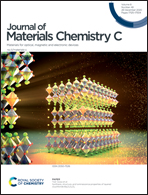α-Cyanostilbene and fluorene based bolaamphiphiles: synthesis, self-assembly, and AIEE properties with potential as white-light emissive materials and light-emitting liquid crystal displays†
Abstract
Novel bolaamphiphiles containing two α-cyanostilbene units interconnected with 2,7-substituted-9,9-dialkylated fluorene as the central core and a diol unit at each terminal have been synthesized efficiently by a palladium catalyzed Suzuki coupling reaction and the Knoevenagel condensation reaction as key steps. POM, DSC and XRD investigation reveals that these compounds can organize into single wall triangular honeycomb columnar phases. A unique packing model was established in which the twisted π-conjugated backbones stacked alternatively into the walls and were connected through the end diol groups to form a triangular honeycomb, and the almost perpendicularly distributed alkyl side chains filled the cells. Such packing was additionally stabilized by the local anti-parallel dipole interactions of α-cyanostilbene and the H-bonding between CN⋯H. These compounds showed the AIEE effect and emitted yellow luminescence which could be further utilized to generate white light emission by coating on a commercially available blue LED lamp. Additionally, light-emitting liquid crystal display (LE-LCD) device could be obtained by dissolution of such AIE active distinctive luminogens in commercially available nematic LCs.



 Please wait while we load your content...
Please wait while we load your content...